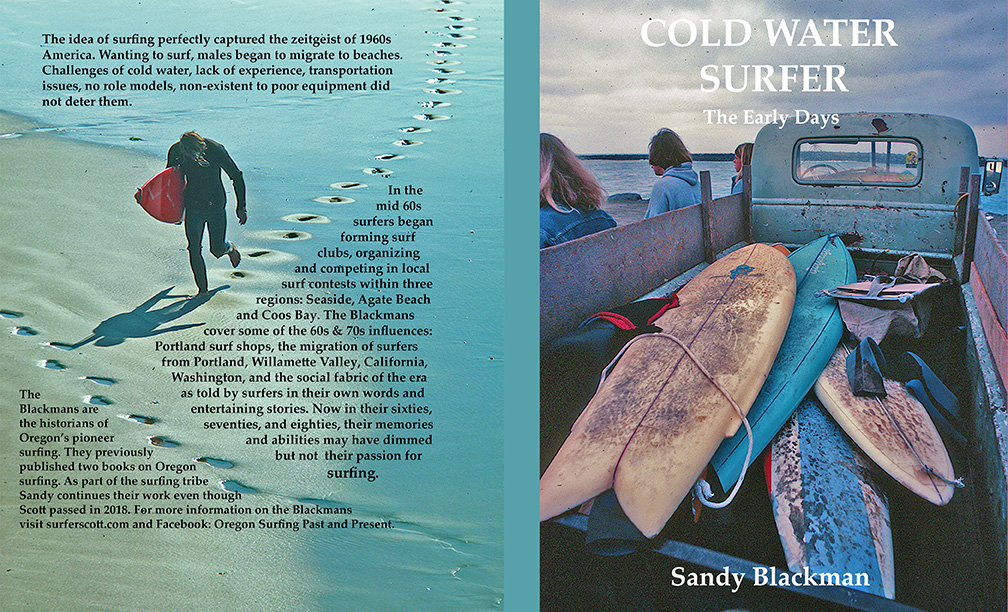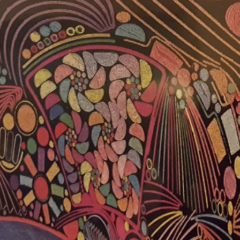Synopsis of “Cold Water Surfer – The Early Days by Sandy Blackman”

Dedicated to Scott Blackman and all pioneer surfers. Due out late 2022.
ACKNOWLEDGEMENT
This book could not have been written without my business partner, creative muse, and husband, Scott Blackman. Like many cold-water pioneer surfers, he persevered and taught himself how to surf in the early 60s. Fortunately he was an artist with many interests and talents who had the foresight and desire to become a photographer. He pursued all his passions until the last three weeks of his life. His interests laid the foundation which enabled us to network with surfers from his early surfing days in the 60s to the present. Like most surfers he studied the tides, observed the winds, waves, and weather patterns, eventually photographing the waves and anyone who was surfing. We networked, photographed, recorded, videotaped, and collected surfing stories and images together. Surfers shared their still images and videos, surfing articles, memorabilia, their personal stories in the hopes of saving Oregon’s surfing history. We shared with them laughter, intimate moments, and great friendships in this journey together. I am indebted to all surfers, family members and loved ones who shared their beloved memories about surfers, past and present. I am proud and grateful to be supported and part of the surfing tribe. There are too many to thank by name in this paragraph. I have quoted everyone who has donated their stories and they have honored many others in them. All have contributed. Last of all a book is only as good as the people who you rely on for technical and writing help. I’d like to thank Debie Howe who takes care of my computer needs, Skip Trantow for website and technical support, my editor and the surfers who have been proofreaders: Greg Gosser, Mike Ehlen, ‘Ohana Baley, Tom McNamara, Steve Price, Wayne Schrunk and Colin Jenkins. Special thanks to surfer, published writer Paul Keller who has helped me to become a better writer.
CONTENTS
ACKNOWLEDGEMENT & DEDICATION
INTRODUCTION
60s SURF CLUBS-CONTEST-SHOPS
Seaside Surfing Association
Agate Beach Surf Club
Coos Bay Surf Clubs
Minor Clubs
MIGRATION
ALTERED STATES
SKATEBOARDING
UNDER THE RADAR
Boy Scout Camp-Pacific City-Neskowin
Lincoln City – Gleneden Beach – Scott’s Reef
Florence-Winchester Bay-Hubbards Creek
60s-70s SURF SPOTS
Seaside-Cannon Beach-Short Sands
Otter Rock-Agate Beach-South Beach
Coos Bay’s Zone:
VISUAL HISTORIANS
INTRODUCTION
Hawaiian Duke Kahanamoku introduced the idea of surfing when he competed in swimming at three Olympics, during 1912, 1920 & 1924. He is credited with popularizing the sport in Hawaii, and California. Surfing music, Gidget the book and movie, early television broadcasts of surfing on Wide World of Sports and the beginning of surfing magazines helped peak interest in the sport. The idea of surfing perfectly captured the zeitgeist of 1960s America.
Interest in surfing began gradually at small, isolated areas and rural beach towns along the Oregon coast in a variety of ways. Adult males who had become skin divers and owned wetsuits saw the possibilities of surfing in the cold waters of Oregon. Other males had been fortunate to experience tropical waters while being stationed in the military or found warmer conditions vacationing in Hawaii or California. Youth who lived in larger cities and the suburbs began to hitch hike, catch rides with family or friends to the beaches to try riding the soup, hopeful to catch some surf-able waves. Locals look at their waves and wondered are they surfable? Surfing began slowly, hidden from most of the mainstream activities, team sports and population centers, suggesting it might be a passing fancy. But many became converts for life.
Some tried it and gave it up due to the cost, lack of experience, no local role models, transportation issues or finding the cold waters more challenging than expected. A very small number of males persisted in total isolation, unaware at first that others like themselves were learning how to surf on their own. Very few females were encouraged or even participated in the early days of surfing. Smitten with the idea of surfing, it became predominantly a male bastion in the early 60s. So great was their desire to become a surfer many took on the surfing lifestyle as their own, affecting their hairstyles, clothing, attitudes, trying to build their own boards, contributing to poor school attendance, looking for temporary jobs or housing to live at the beach full time. As surfers found each other within their geographic regions they began to form clubs during the early 60s. This became their identity for a short period of time as they eventually organized and competed against each other in local surf contests. There were so few surfers in the beginning that they could identify each other driving along the entire Oregon coast from Coos Bay, Agate Beach, and Seaside. The surfing tribe slowly grew and became a brotherhood that still exists today among Oregon’s original surviving pioneer surfers. This book is part history, part anecdotal stories as told in their language from their memories. Most are now in their sixties, seventies, and eighties, some have already passed on. For this book, we identify males/females who surfed in Oregon during the 60s and-or 70s as pioneer surfers.
THREE DOMINANT SURFING REGIONS
The three dominant surfing regions in the early to mid-60’s were Seaside in the north, Agate Beach in the central coast and Coos Bay in the south. Each of these regions were unique with very different origin stories based on their locations, surf clubs, quality of waves, influences by local and migrating surfers.
Seaside – was heavily influenced by three non-local adult males: Dana Williams, an experienced San Diego surfer stationed with the military at Tongue Point who formed the Seaside Surfing Association (SSA), the first surf club in Oregon; Dick Wald, a Portland CPA, married with two small children, an active skin diver who surfed The Point first; Jim Sagawa, a board maker from Hawaii who was attending OHSU Dental school in Portland. Surfing began in 1961, and Seaside became the last region to finally sponsor a surf contest in February 1966 by a skin-diving club.
Agate Beach – Surfing began in earnest the summer of 1964 with three locals: Scott Blackman 26, home after 4 years in the Air Force, working for the Forest Service; Rick (‘Ohana) Baley 17, soon to be a senior at Newport High School, living in Agate Beach with parents; Larry Tucker, 17, a Newport High School graduate, employed as a skin diver at the Under Seas Gardens. Together they started surfing in 1964, formed the Agate Beach Surf Club in July 1965. The three sponsored the first surf contest at Agate Beach, August 1965.
Coos Bay – Formed two surf clubs, The Kahuna Club, made of older males who were employed or students at SOCC, the local community college. This group hosted the first surf contest in Oregon, the summer of 1965. The second surf club, Kapaa Kea were younger, and mostly students attending Marshfield High School. Greg Keylock is credited with being the first surfer. Jim and Bill Theiring, entrepreneurs were the first surf shop owners in Coos Bay, Seaside, and Portland. They financed Bruce Brown’s Endless Summer, for the Kahuna’s Surfcapades surf contest. The movie was the first surfing movie to be narrated and shown in public auditoriums in Oregon, 1965.
Besides the three regions the book will cover some of the smaller, minor surf clubs, skateboarding, the influence of Portland surf shops, the migration of surfers to the beaches from Portland, the Willamette Valley, California, and Washington. As a nod to the 60s influences on the social fabric of the times, we will cover the Seaside Riots, the viewing of Endless Summer by Bruce Brown, and the use of drugs and alcohol within the surfing culture. We honor some of the visual historians who specialized in either the still image, videotaping or the reel-to-reel movies with 8-millimeter movie cameras. Without them there would have been no visual record of surfing in the early days. Surfer’s personal stories will highlight most of the major surfing spots: Seaside’s Cove, first and second Point; Indian Beach, Short Sands; Boy Scout Camp, Pacific City, Neskowin; Lincoln City, Gleneden Beach, Scott’s Reef; Otter Rock, Agate Beach, South Beach; Florence, Winchester Bay, Coos Bay’s zone; and Hubbards Creek.
The entire book will be told through the verbal and written stories of pioneer surfers, their families, and friends. In 2008 the Blackman’s began collecting surfing memorabilia, newspaper articles, posters, written stories, and emails. Along with Scott’s surfing images beginning in the 60s, many surfers have donated their surfing photos and early videos of Oregon surfers to our projects. The Blackman’s have interviewed or videotaped approximately 50 Oregon pioneer surfers since 2012.
Together the Blackman’s co-authored two other Oregon surfing books before Scott Blackman died in 2018. Sandy has continued their work on her own since then. Surfing images of the 60s & 70s can be seen at Blackman’s Facebook page: Oregon Surfing Past and Present. Information about the Blackman’s, Scott’s images, their books, can be found on their website: Surferscott.com. The site also features the Cold Water Surfer slide show and the video Surfing Agate: An Exuberant Dance of Youth.
XXXXXXXXXXXXXXXXXXXXXXXXXXXXXXXXXXXXXXXXXXXXXXXXXXXXXXX
COLD WATER SURFER COMMENTS FROM PROOF READING SURFERS
MIKE EHLEN: I read the whole thing in 3 days. Quite fast for me as I’m a slow reader. I have to say, as an old first-generation Oregon Surfer, I could not put this down. Extremely compelling, delightful, and oddly vindicating for me. I thoroughly enjoyed this substantial amount of work you put together. Can’t thank you enough.
Truly amazing stories, lives and history molded and sculpted by the magic on the salty seas. It helps me feel like I made some good choices in life and share that with so many others. Just wish I could have known Scott and some of the other crew better. But the stories of the ones I do/did know like Prator, Dana, Perry, Tillamook Head guys, Spence, Barnfield, Tim Foley of course Gosser, Randy Barna, Josh, Sandy Barret, The shops etc etc. Wowwser!
GREG GOSSER: Truly a riveting collage that’s hard to put down especially if you are at all familiar with Oregon Surfing! It’s a compelling riveting Historical drama a True Love story of boys and their boards, definitely a page turner and a summer read you can’t put down.
OHANA BALEY: ” The Blackman’s many extensive interviews and Sandy’s technique of overlapping storytelling provide a lively, multifaceted look at the early years of surfing in Oregon. There is a vibrant energy contained within the narrative, due perhaps to all the different voices singing stories of their youth upon the waves. ” Aloha, ‘Ohana
